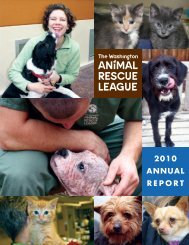2009 ANNUAL REPORT - Washington Animal Rescue League
2009 ANNUAL REPORT - Washington Animal Rescue League
2009 ANNUAL REPORT - Washington Animal Rescue League
Create successful ePaper yourself
Turn your PDF publications into a flip-book with our unique Google optimized e-Paper software.
The <strong>League</strong>’s Medical Center sees pets of low-income clients who cannot<br />
afford to pay regular veterinary fees. The center also provides<br />
weekly low-cost vaccination clinics and routinely offers free spaying<br />
and neutering. Each month, the center sets aside separate days to spay<br />
and neuter feral cats and pit bulls, the two types of animals who suffer<br />
most from overpopulation.<br />
To Alleviate Suffering,<br />
Area Specialists Go the Extra Mile<br />
e <strong>Washington</strong> <strong>Animal</strong> <strong>Rescue</strong> <strong>League</strong> is the<br />
only shelter in the <strong>Washington</strong> area that provides<br />
medical care to animals from other shelters<br />
and those whose caregivers are unable to<br />
afford the cost. Oen, these surgeries require<br />
the services of a specialist. Fortunately, one of<br />
the best veterinary orthopedic surgeons in the<br />
area—if not the country—contributes his time<br />
and expertise. However, his skills are in great<br />
demand, and he has almost no free time.<br />
Lately, the only openings on his calendar have<br />
been between midnight and 8:00 a.m. So that’s<br />
when the surgeries take place.<br />
e first overnight session occurred on<br />
January 14, <strong>2009</strong>, when the volunteer surgeon<br />
(who prefers to remain anonymous), a <strong>League</strong><br />
veterinarian, and five veterinary technicians<br />
completed five complicated bone surgeries<br />
and six in-depth, X-ray examinations. Four<br />
out of five of the animals who underwent<br />
surgery belonged to members of the lowincome<br />
community whom the <strong>League</strong> serves<br />
at a discount of one-eighth the going rate for<br />
such surgeries elsewhere. e other case was<br />
a shelter dog with an injured knee.<br />
“We always try to ensure that as many animals<br />
as possible can get surgery here,” says Dr.<br />
Janet Rosen, DVM, the shelter’s medical director.<br />
Shelter animals get first priority, followed<br />
by animals belonging to low-income residents<br />
of the District. “Without surgery,” says Rosen,<br />
“most of these animals would have to be euthanized<br />
or live in chronic pain.”<br />
At another session, held on February 4, the<br />
team treated seven dogs and two cats for a<br />
variety of bone problems, some of which were<br />
causing lameness in the animals. e most<br />
complicated surgery of the night was a<br />
femoral head ostectomy, where the tip of the<br />
femur was removed to create a “false joint”<br />
that relieves arthritis pain.<br />
Accident Victim Learns to Walk Again<br />
When Diego, an 18-month-old mixed terrier<br />
from Waldorf, Maryland, got hit by a car, his<br />
family rushed him to an emergency hospital.<br />
One of the dog’s legs was broken, several of<br />
the toes were badly dislocated, and all of the<br />
skin on the dog’s leg had been torn off. When<br />
the family was shown an estimate for how<br />
much it would cost to fix the leg, they reluctantly<br />
concluded that they could not afford it<br />
and surrendered their dog to the local shelter.<br />
Most shelters cannot afford expensive surgery<br />
either, so in July <strong>2009</strong> Diego was transferred<br />
to the <strong>League</strong>’s Medical Center for extensive<br />
wound care, followed by physical<br />
therapy. “Our typical costs run from $400 to<br />
$1,000 for surgery,” says Medical Director Dr.<br />
Jan Rosen. “If we did not receive generous donations<br />
of services from surgeons, it would be<br />
up to $4,000, and we wouldn’t be able to provide<br />
as much.”<br />
According to Rosen, Diego’s initial treatment<br />
involved daily bandage changes and<br />
wound treatment under anesthesia, as well as<br />
antibiotics and pain medications. He also got<br />
numerous “honey wraps”; regular honey, it<br />
turns out, is effective for helping skin grow<br />
back. Despite these measures, he lost two of<br />
his toes.<br />
Aer losing the toes and living with his leg<br />
in a cast for weeks, Diego decided he was not<br />
going to use the leg anymore. But a volunteer<br />
orthopedist assured the <strong>League</strong> staff that the




